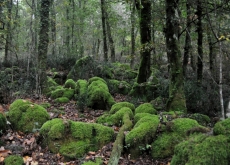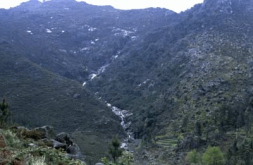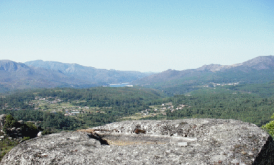O
The Natural Park of "Baixa Limia-Serra do Xurés" is located in the southwest of the Galician province of Ourense, and extends into the region of Baja Limia. It has a surface area of 20,920 hectares, covering the higher elevations of the municipalities of Entrimo, Lobios and Muiños, which borders Portugal at the Portuguese National Park of Peneda-Geres.
Its declaration as Natural Park, by the Decree 29/1993, of 11th February, meets the requirement to protect the important natural, orographic, landscaping, ethnographic and archeological wealth of the area, but also the appropriate use of available resources, in order to achieve good management and utilization, among other things, from the tourism point of view.
Landscape
The landscape is one of the great attractions of this park. The mountains are typical of the northwest of the Iberian Peninsula and combines rugged mountains with other soft ones, where granite stands out for its grandeur. This contrasted and varied landscape setting is of singular beauty and provides the park with an exceptional environmental classification, in which the granite boulders, glacial sediments that forms the so-called "Pedras Caballeras", are the most typical feature of the landscape.
Water is another physical element which has a significant presence and stands out in this park. Streams created by the force of the rain flow through the cracks of the mountains and form waterfalls that offer a spectacular sight for the eyes of visitors.
Water also shows itself in a quieter way, such as in the reservoirs of Salas or Lindoso, created prior to the declaration of this natural reserve, where you can practice water sports and sports that do not require combustion engines, thereby having no impact on the natural environment. It is also worth mentioning the existence of medicinal mineral waters that enable the development of spas, as well as highlighting the thermal resort of Vila Lobios.
Flora and Fauna
Despite the uniformity of the soil, there is great ecological variety. The region of Baixa Limia is located in a transition zone between two large floral regions of Europe: the Euro-Siberian (Atlantic province) and the Mediterranean (carpetana-Leon province). Due to this fact, vegetation shows an alternance of deciduous trees typical of wet areas, and evergreen trees, together with cork oaks or "albedros", which are more adapted to the lack of water during certain times of the year. In the lower elevations there are forests of oak and cork trees. The shrub of these areas is comprised of by brooms, white heathers, gorses and some species with more thermal requirements than cistus, broom (xilbarbeira) and "albedros". As the altitude increases, we can observe that the pyrenean (rebolo) gradually replaces the oaks, the holly trees, yews, heathers, roses, "arandeiras". "gamons", "albedros", birches, wild pines, and even some isolated examples of "capudre" (Sorbus aucuparia). Herbaceous plants of weak coverage also start to appear at these higher elevations.
As regards to the fauna, the contrasting landscapes of the natural park, with its orographic diversity and varied vegetation, allowed the acclimation and sheltering of the fauna. However, uncontrolled human actions caused the extinction of species such as the bear and the "Xurés goat". Their reintroduction into the mountains of the area is one of the main points of action by the Galician Administration, since these rugged areas provide excellent conditions for breeding them in the wild..









